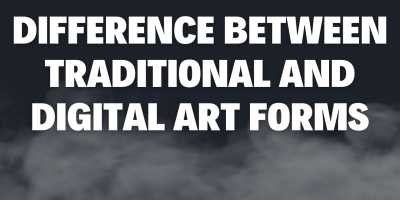Last Updated on June 23, 2024 by Rojgar Buddy Team
Traditional and Digital Art Forms : Art is a way people express their thoughts, feelings, and creativity. Over time, artists have used many different methods to create their work.
These methods can be grouped into two main categories: Traditional and Digital Art Forms. This article will explain the differences between these two forms of art in simple language.
Traditional and Digital Art Forms : What is Traditional Art?
Traditional art includes any kind of artwork made with physical materials. This can include:
- Drawing: Using pencils, pens, or charcoal on paper.
- Painting: Using paints like watercolor, oil, or acrylic on canvas or paper.
- Sculpting: Carving or modeling materials like clay, stone, or wood into three-dimensional shapes.
- Printmaking: Creating images by printing them from a specially prepared surface, like a block or a plate.
Artists have been creating traditional art for thousands of years. Famous examples include the paintings in the caves of Lascaux, France, and the sculptures of ancient Greece.
Traditional and Digital Art Forms : What is Digital Art?
Digital art is made using digital technology. This can include:
- Digital Drawing and Painting: Using software like Photoshop or Procreate on a computer or tablet.
- 3D Modeling and Sculpting: Creating three-dimensional shapes using software like Blender or ZBrush.
- Digital Photography: Taking photos with a digital camera and editing them on a computer.
- Animation: Creating moving images using software like Adobe Animate or Maya.
Digital art has become popular in recent years because of advances in technology. It allows artists to create and share their work easily and quickly.
Materials and Tools
Traditional Art Materials
In traditional art, artists use physical materials. Some common ones are:
- Paper and Canvas: Surfaces for drawing and painting.
- Pencils, Charcoal, and Pens: Tools for drawing.
- Paints and Brushes: Used for painting. Different types of paints include watercolor, acrylic, and oil.
- Clay, Stone, and Wood: Materials for sculpting.
- Ink and Printing Plates: Used in printmaking.
Artists need a space to store their materials and a studio to work in. This can sometimes be expensive and take up a lot of room.
Digital Art Tools
In digital art, artists use electronic devices and software. Some common tools are:
- Computers and Tablets: Devices where the art is created.
- Stylus: A pen-like tool used on tablets for drawing and painting.
- Software: Programs like Photoshop, Illustrator, Procreate, Blender, and ZBrush.
- Digital Cameras: Used for taking digital photographs.
Digital artists need their devices to be powerful enough to run their software smoothly. They also need to learn how to use different programs, which can take time.
Techniques and Methods
Techniques in Traditional Art
Traditional art techniques vary depending on the material and tool used. Some examples include:
- Drawing: Techniques like hatching, cross-hatching, stippling, and blending to create different textures and effects.
- Painting: Techniques like layering, glazing, dry brushing, and impasto to build up colors and textures.
- Sculpting: Techniques like carving, modeling, and casting to shape the material.
- Printmaking: Techniques like etching, lithography, and screen printing to produce multiple copies of an image.
These techniques have been passed down through generations and often require a lot of practice to master.
Techniques in Digital Art
Digital art also has its own set of techniques, which can be very different from traditional ones. Some examples include:
- Digital Drawing and Painting: Using layers to separate different parts of the image, using brushes that can simulate traditional tools, and applying effects like gradients and filters.
- 3D Modeling and Sculpting: Techniques like extrusion, sculpting with digital brushes, and adding textures to models.
- Photo Editing: Techniques like cropping, color correction, retouching, and adding digital effects.
- Animation: Techniques like keyframing, rigging, and using motion capture data to animate characters.
Digital techniques can often be learned through tutorials and online courses, making them more accessible to beginners.
Advantages and Disadvantages
Advantages of Traditional Art
- Tactile Experience: Artists can physically touch and manipulate their materials, which can be satisfying.
- Unique Pieces: Each artwork is one-of-a-kind and has a physical presence.
- Historical Value: Traditional art has a long history and is often seen as more prestigious.
- No Technical Issues: Traditional art doesn’t depend on software or hardware that can malfunction.
Disadvantages of Traditional Art
- Cost: Materials and tools can be expensive, and artists need space to work and store their supplies.
- Time-Consuming: Some techniques take a long time to learn and execute.
- Limited Reproduction: Making copies of traditional art can be difficult and expensive.
Advantages of Digital Art
- Flexibility: Artists can easily make changes and experiment with different techniques.
- Cost-Effective: Once they have the necessary tools, artists don’t need to keep buying materials.
- Easy Reproduction: Digital art can be copied and shared effortlessly.
- Access to Tools: Artists have access to a wide range of tools and effects that can simulate traditional techniques.
Disadvantages of Digital Art
- Learning Curve: It can take time to learn how to use different software and tools.
- Technical Issues: Artists may encounter problems with their devices or software.
- Perception: Some people may view digital art as less valuable or prestigious than traditional art.
Impact on the Art World
Traditional Art’s Influence
Traditional art has been the foundation of art history. Many famous works, like the Mona Lisa by Leonardo da Vinci and The Starry Night by Vincent van Gogh, are traditional pieces. Museums and galleries around the world display these works, and they are studied in art schools.
Digital Art’s Rise
Digital art has changed the art world in many ways. It has opened up new possibilities for artists and allowed them to reach a global audience through the internet. Digital art can be found in video games, movies, advertisements, and on social media. It has also led to new forms of art, like digital installations and virtual reality experiences.
Combining Traditional and Digital Art
Some artists combine traditional and digital techniques in their work. For example, they might start with a pencil drawing, scan it into a computer, and then add color and effects digitally. This approach allows artists to use the strengths of both methods and create unique pieces.
Conclusion on Traditional and Digital Art Forms
Difference Between Traditional and Digital Art Forms : Both traditional and digital art have their own unique qualities and benefits. Traditional art offers a tactile, hands-on experience and a deep connection to art history. Digital art provides flexibility, accessibility, and new creative possibilities. Each form has its own challenges and rewards, and both are important parts of the art world today.
Whether you prefer traditional or digital methods, the most important thing is to express your creativity and enjoy the process of making art. Each artist can choose the tools and techniques that work best for them and explore the endless possibilities of artistic expression.
FAQs on Traditional and Digital Art Forms
What defines traditional art?
Traditional art encompasses various art forms that use physical media such as paints, pencils, clay, and canvas. Techniques like drawing, painting, sculpture, and printmaking are categorized under traditional art.
What is digital art?
Digital art is created using digital technology, typically through software on computers or tablets. Tools include graphic design programs, digital painting software, and 3D modeling applications.
What are the main tools used in traditional art versus digital art?
Traditional art uses tools such as brushes, paints, pencils, charcoal, and paper or canvas. Digital art utilizes hardware like graphics tablets and styluses, along with software like Adobe Photoshop, Corel Painter, and Blender.
How do the processes of creating traditional and digital art differ?
Traditional art involves manual techniques and tangible materials, often requiring physical space and tools. Digital art is created using electronic devices and can involve layers, undo/redo functions, and a wide range of virtual tools and effects.
Can digital art replicate the textures and feel of traditional art?
Digital art can simulate the textures and effects of traditional media through various software tools, but the tactile experience of handling physical materials is unique to traditional art.
Is digital art easier to learn than traditional art?
Both art forms have their own learning curves. Digital art may be more accessible due to undo functions and digital tutorials, while traditional art often requires mastering physical techniques and materials.
What are the cost differences between traditional and digital art?
Traditional art can incur ongoing costs for materials like paint, canvas, and brushes. Digital art involves initial investments in hardware and software but typically has fewer recurring costs.
How do traditional and digital art differ in terms of preservation and longevity?
Traditional artworks can be susceptible to damage and decay over time, requiring careful preservation. Digital art, however, can be easily stored, copied, and preserved indefinitely as long as digital files are properly backed up.
Are there differences in the way traditional and digital artworks are displayed and shared?
Traditional art is often displayed in physical galleries, museums, and private collections. Digital art can be displayed on screens, projected, or shared online through websites and social media.
Can traditional artists transition to digital art easily?
Many traditional artists find transitioning to digital art relatively smooth, as the foundational principles of art remain the same. The main challenge is becoming proficient with new tools and software.
Also Check Out :
Difference Between Wet and Dry Process of Cement


